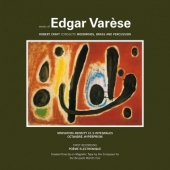
Varese Edgar
Music Of Edgar Varese Vol. 1
Label: Modern Silence
Genre: Jazz / Avant Garde
Availability
- LP 180gr €17.99 Out of Stock
<p>OCTANDRE, composed in 1924, for an ensemble of flute (alternating with piccolo), clarinet (alternating with piccolo clarinet), oboe, bassoon, horn, trumpet, trombone, string bass, is the only work of Varèse’s to follow a traditional division of movements—though, of the three, no break occurs between the second and third.<br /><br /><br /><br /> HYPERPRISM dates from the same year as Octandre (…) Hyperprism begins with percussion alone. Two other passages for percussion solo can be counted. Otherwise, with the exception of one rhythmic unison with the brass, the percussion group is always distinguished from the winds by differences of rhythmic pattern.<br /><br /><br /><br /> The Poème Èlectronique , an example of Organized Sound, the technique that has come to occupy Varèse’s attention since Density 21.5 (he rejects the term musique concrete as inapplicable to his kind of composition), was created in close collaboration with the architect Le Corbusier for the Philips Radio Corporation’s pavilion at the Brussels Exposition. Le Corbusier designed the pavilion in the shape of a three-peaked circus tent externally and (to use his own analogy) in the shape of a cow’s stomach internally. This provided a series of hyperbolic and parabolic curves from which Varèse could project his 480-seconds-long composition. Along these curves, placed with infinite care, were no fewer than 400 loudspeakers through which the Poème swept in continuous arcs of sound. The sound itself was accompanied by a series of projected images chosen by Le Corbusier, some of them photographs, others montages, paintings, printed or written script. No synchronization between sight and sound was attempted by the two artists; part of the effect achieved was the result of a discordance between aural and visual impressions and part the result of their not infrequent accidental concordance. The audience, some fifteen or sixteen thousand people daily for six months, evinced reactions almost as kaleidoscopic as the sounds and images they encountered— terror, anger, stunned awe, amusement, wild enthusiasm. <strong></strong><em></em></p>
